
|   |

|   |
Thrayam portrays the varied aspects of number three - Vijay Shanker e-mail: vijaydance@gmail.com August 12, 2022 Dance, when presented as an experience, is amazing in its ability to draw the viewer through the power of intention and suggestion to define a theme and bring it to life. When presented with depth, classical dance becomes the umbilical cord which connects us, not only with our inner selves but also the world for which dance should transform to a one to one experience. The festival 'Thrayam' at the NCPA Experimental Theatre, Mumbai, on July 2nd was an other worldly experience with a holistic perspective providing various aspects and dimensions to number three, the three gunas - sattvik, rajasik and tamasik; the three aspects of human life - prana (life, breathing), deha (body) and manas (intellect); the three types of consciousness - consciousness, subconscious and unconscious; and the three elements of nature, pertaining to pancha bhutas - air, water and fire vital for human existence and well being. It was enthralling and interesting to watch dancers in different styles, trying to reach out through the thematic content of 'thrayam'. The houseful theatre cheered the imaginative curator Dr. Lata Surendra as she stepped on to the stage to reach out with highlighting the romance of the number three through seasoned and exemplary artists. The anticipation of the crowd was obvious as they listened intently to her introduction to an Ode unto the poetry of Three, through the bridging metaphor - dance! She awakened people to the Tri-particle nature of all existence as heaven, earth, water and in the human body, spirit and soul. The two hours that followed was a journey into the very pulse of three. 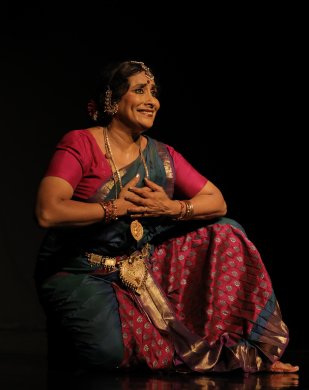 Vyjayanthi Kashi Kuchipudi exponent Vyjayanthi Kashi, the artistic director of Shambhavi School of Dance, explored three through Triguna - three attributes of sattvik, rajasik and tamasik through the mystery that is the woman. Sharmishte, daughter of Vishparva, as her life proceeds through various stages of both progression and regression, her moments of selfish tamas, phases of rajasik abandon and silent spaces of sattva. Devyani is the friend of Sharmishte and the daughter of Shukracharya. A playful prank and a momentary exchange of clothes, led to the tussle, wherein Sharmishte pushed Devyani to the well but was rescued later. Shukracharya was disturbed to see the distress in her face. Will he curse to ruin the kingdom of Vishparva? Sharmishte realizes her folly and decides to leave the palace to join Devyani as her maiden. A curse prevented is a boon almost, thinks Sharmiste but life would show her otherwise. There is always an element of spirituality and philosophy that seeps through each production of this consummate artist, as she dances with complete dramatic involvement creating a lasting spell on the audience, a great start to this unusual program. 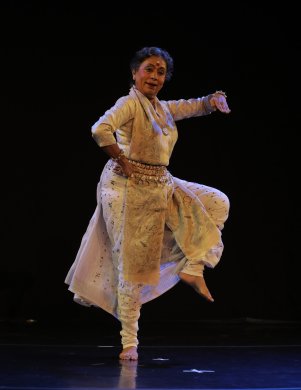 Jhelum Paranjape Odissi exponent Jhelum Paranjape, founder of Smitalay, presented the flow of the number three through the three identities of Narmada as the Goddess, the mother and the river. An artiste with a unique vision and a signature style that etched Odissi in every movement, she reached out with the eloquence of three varied aspects of river Narmada. Jhelum's independent thought process was reflected in her moving away from the traditional attire of Odissi to a more contemporary aharya in white that gathered the kinesthetics of her chosen style, beautifully endorsing that the sattvika soars beyond the tangible and visible. In fact not once did it come in the way of her exploring Thrayam. 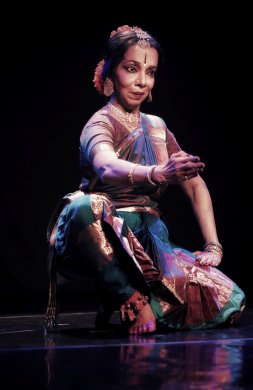 Lata Surendra Bharatanatyam exponent Lata Surendra explored three with two pieces. She commenced with an exploration of Vasuki, the snake coiled three times around the neck of Lord Shiva representing the three forms of time - past, present and future - that we transit through. An intricately choreographed piece set to thisra jathi dhruva thalam in 11 aksharas, she dedicated it to her legendary Guru T.S. Kadirvelu Pillai to commemorate her six decades of performing career, since her debut in 1962. She also defined the number three through the effulgent form of Tribhangi Krishna, highlighting the truth of Radhamayi Krishna, as Krishna leaves Vrindavan to reach out to the true purpose of his incarnation. The synergy of technique and emotion; rhythm and bhava flowed through her vibrant form, holding the audience spellbound. Be it the impact of her feet echoing all around executing the dhruva thalam to drape Vasuki in the symbolically structured Alarippu or heart wrenching portrayal of Krishnathmika Radha, transforming to Tribhangi Krishna, technique and emotion merged as a visual poetry flowing through her as she awakens to the true purpose of Krishna's incarnation. 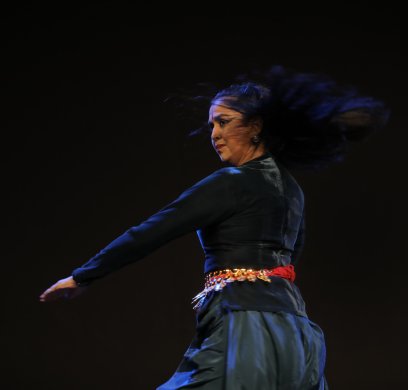 Sanjukta Wagh An imaginative choreographer, Kathak exponent Sanjukta Wagh explored Kaali, the great mother who is an embodiment of time itself, her magnificence, her ferocity and her deep love and compassion for all beings. Inspired by her grand Guru Madhurita Sarang, the song was a traditional Kathak piece by Mahavirji rearranged and choreographed by Sanjukta Wagh with her fellow musicians Hitesh Dhutia on the guitar, Vinayak Netke on percussions and Radhika Sood Nayak on vocal. Priya Sarukkai Chhabria's evocative poem on the mother goddess and her symbolism tied up the soul connection and the relationship between the divine and blessed, the poet and muse, the artist and the audience. An absolutely consummate artist with a vision, she truly transformed to the dark energy, the passion, the raw feminine that was as merciless as merciful. 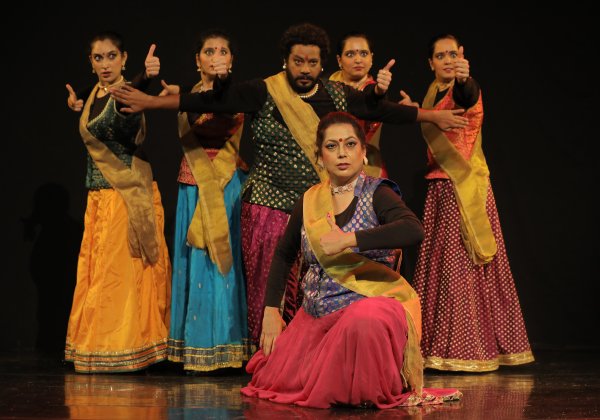 Manisha Jeet and group The absorbing pathways unfolding, soon gathered its climax in the imaginative choreography of Manisha Jeet that defined the journey of the genderless intangible through three genders - saa, thath, saha. The team headed by Manisha Jeet, enthralled the audience with the magic of Saa - Stree, Thath - Shikhandi and Saha- Kal Bhairav. The energized execution of the artistes with beautifully coordinated movements and uttered vachika defined the finale with aplomb. The perfect coordination and synchronization between the dancers, the powerful portrayals and the captivating lighting made the entire experience absorbing. The climax had Lata Surendra urging the audience to clap to thisra in three layas and changing gatis as a tribute to Three. What a great evening gathering the poetry of the number three, through the three elements of nritta, nritya and natya. In the words of curator Lata Surendra, "Post witnessing Thrayam, the number 'Three' would have transformed to more than a number! In the tri-particle nature of the universe, three would reign as the perfect number gathering the pulse of the universe through each of its symbolic definitions in the sacred symmetry that embodies life." She thanked her sponsors the Union Bank of India and Mahindra Finance for their support in reaching out with the divinity of three. 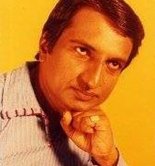 Vijay Shankar is a Kuchipudi and Kathakali exponent, teacher, bilingual journalist, arts critic and actor. |